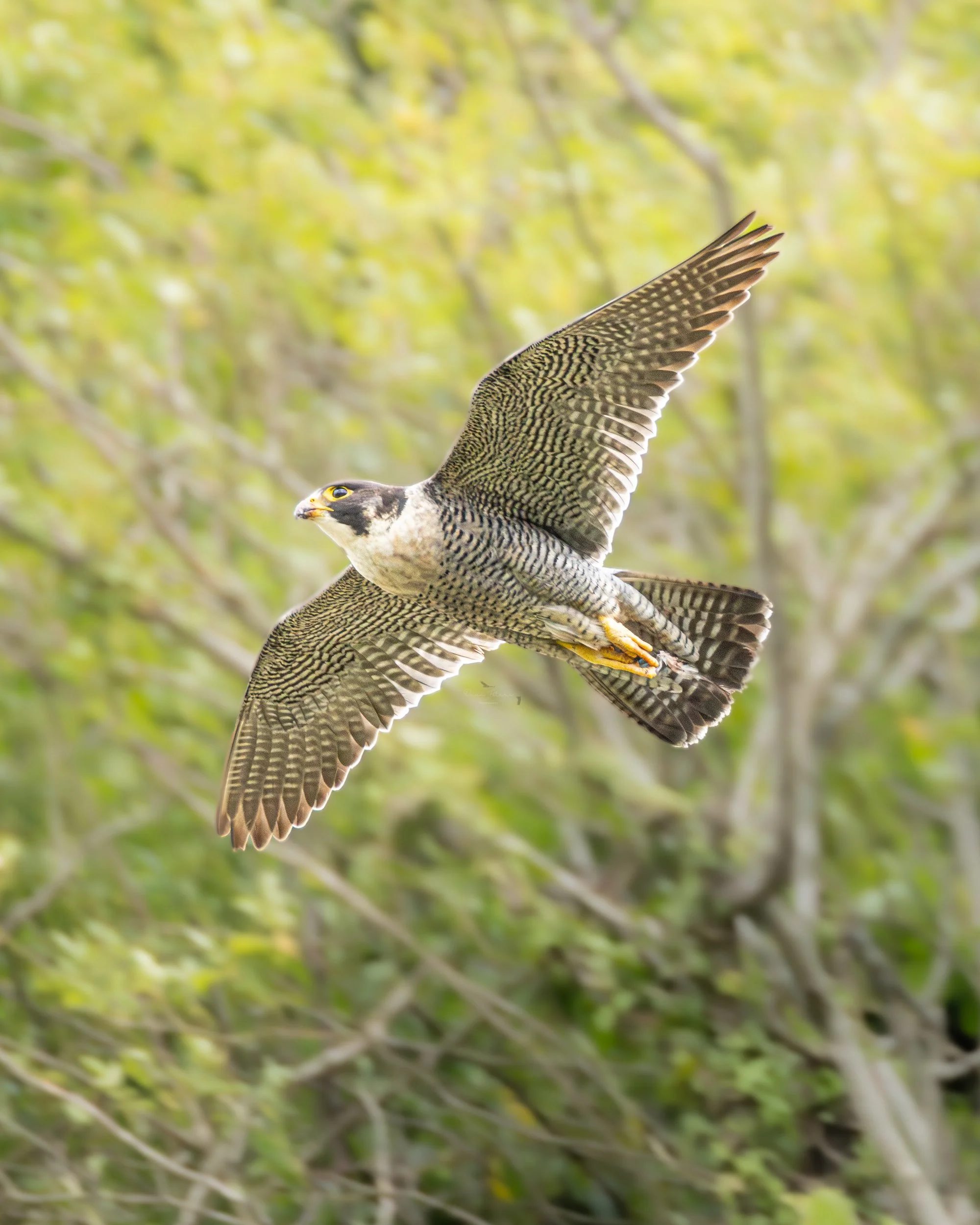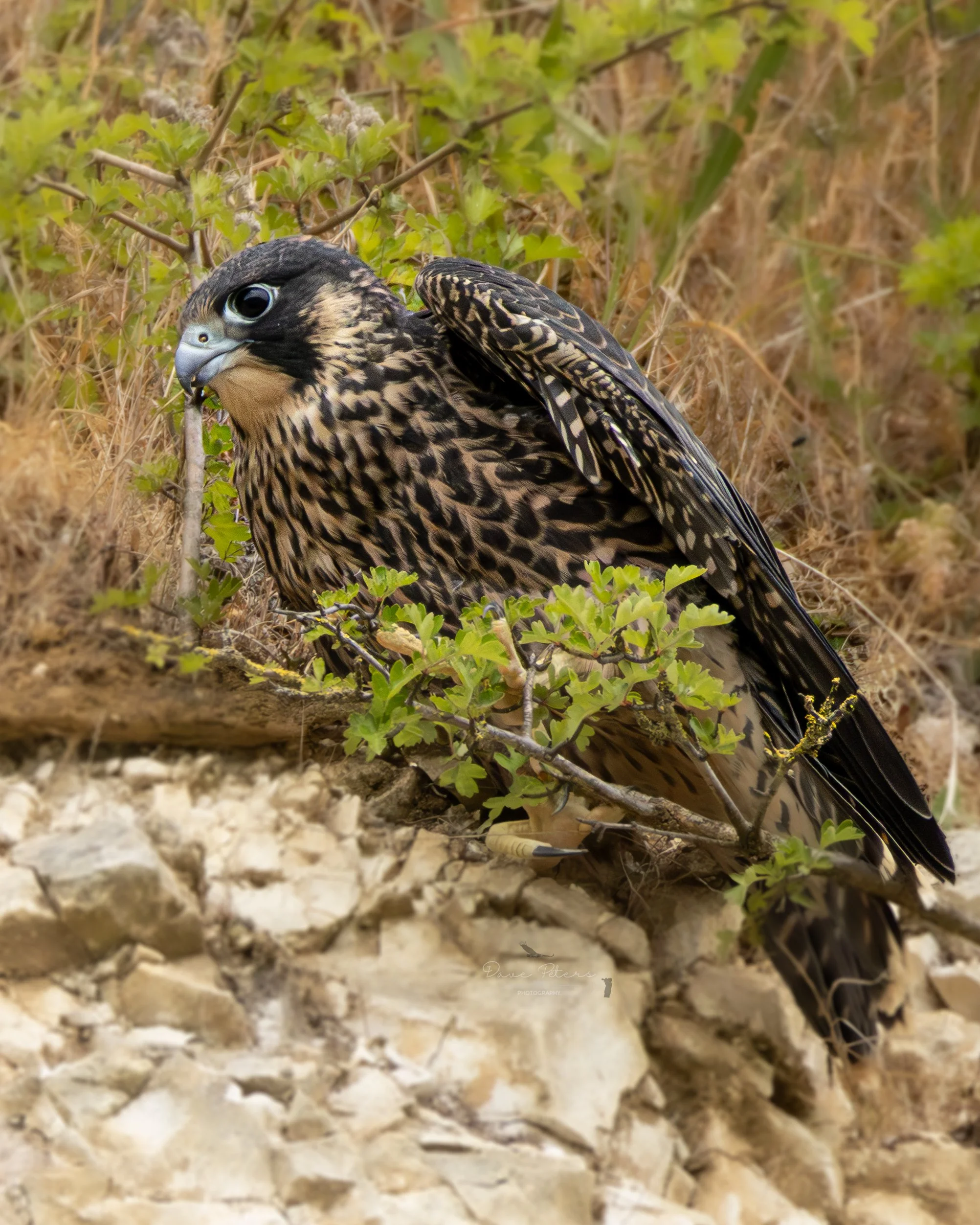Urban Falcons: Five Years with a Peregrine Family on the Clifftop
How a local tip-off became a five-year journey into the secret lives of the world’s fastest bird—right above the town.
Witnessing wildness from the edge of the everyday
Just after the first lockdown, my dad got a quiet tip-off from a local birder.
A pair of peregrine falcons had been seen hunting nearby—and possibly nesting on a cliff face just beyond the edge of a residential zone. We went to check it out. It was barely a five-minute drive or a 20-minute walk from home, but it felt special from the outset on arrivle.
Sure enough, the birds had claimed the rocky ledges of the cliff as their territory. Despite being so close to people—dog walkers, joggers, and even a play park—the birds were thriving.
This image was taken at 800mm and heavy crop.
My first photos came in May or early June 2020, taken with my Canon 70D and Sigma 120–400mm my first DSLR and telephoto lens combo. I posted them to Instagram, not realising it would be the start of something long term.
Mum feeding her young delicately pulling off small chunks of meat (images taken from the car and very heavily cropped.)
Respect and Distance
From then on, I visited sporadically, always careful not to draw attention or cause disturbance, especially since peregrines are a Schedule 1 protected species under UK law. It’s illegal to interfere with them or risk the welfare of young birds.
Fortunately, the layout of the site meant I could observe from a designated car parking space, giving me close views from the comfort of the car without getting anywhere near the nest. Over time, it became a rare privilege to watch their life cycle unfold in such a wild yet accessible place.
Learning With the Birds (and the Gear)
Without realising it at first, this territory became a kind of field lab for every upgrade I made to my photography kit. Here’s how that progression played out:
• 2020 – Canon 70D + Sigma 120–400mm
My first telephoto lens, used to capture my earliest falcon images (shared on Instagram).
• 2021 – Canon 70D + Sigma 150–600mm 70D
A big jump in reach and quality—heavier, but allowed for closer portraits.
• 2022 – Canon 7D Mark II
One of my favourite setups. That spring, I captured a breeding pair on the rocky ledge. One of the resulting videos became my most-viewed Instagram reel ever.
• 2023 – Canon R7 + RF 100–400mm + 1.4x extender
My first mirrorless setup: lighter and sharp, though slightly slower in low light.
• 2025 – Canon R7 + RF 200–800mm
Huge reach, faster shutter speeds, and still more portable than my old Sigma.
2025 – A Fledgling’s First Stoops
In early summer, I had one of the most remarkable experiences yet. One of the adults—likely the female—was circling overhead with prey in her talons, possibly a jackdaw. But she wasn’t feeding the fledglings straight away.
Instead, she performed repeated low flybys clearly displaying the food, encouraging one of the juveniles to respond.
Eventually, one did. It launched into flight and made an instinctive attempt to divebomb a nearby jackdaw. No contact was made, but the motion and shape of the stoop were unmistakable.
It was raw, natural learning ,a young peregrine’s first hunting move, played out just metres in front of me..
The falcon flew repeated circuits above the site, showing the food to a nearby fledgling perched on a rocky ledge. It was training through example an incredible moment of behavioural learning, not often witnessed this closely.
Reflections: Rocky Ledges, Town Sounds, and Wild Air
Looking back, it’s hard to believe how much has changed since that first visit in 2020. What started as a local tip-off became a five-year connection with one of the UK’s most iconic raptors. These birds taught me not just about falcon behaviour, but about how wildlife and people can coexist.
Nestled just above the daily bustle joggers, children playing, roads, and rooftops these peregrines continue to nest, hunt, feed, and fledge.
Wildness is never far away. Sometimes, it’s right above us.
Peregrines: A Comeback Written on the Cliffs
How the UK’s fastest bird bounced back from collapse—and found a home above the rooftops
It’s amazing to think that just a few decades ago, peregrines were almost wiped out across the UK. During the 1960s and ’70s, their numbers plummeted ,mostly due to pesticides like DDT, which built up in their systems and caused their eggshells to thin and fail. In some parts of the country, they vanished completely.
Thankfully, that wasn’t the end of the story.
Conservation groups stepped in. DDT was banned. Peregrines gained full legal protection under the Wildlife & Countryside Act. Breeding and release programmes helped them begin to recover, and rooftop nest cams run by passionate volunteers gave people a chance to see these birds up close without disturbing them.
Today, peregrines are a real conservation success. There are now thought to be around 1,700 breeding pairs in the UK similar to or even higher than their pre-crash numbers. Some still cling to remote uplands, but more and more have found a way to live in our world: on tower blocks, cathedrals, pylons, and the kind of quiet cliff face just beyond the edge of town.
We owe much of that recovery to the efforts of organisations like:
RSPB (Royal Society for the Protection of Birds)
British Trust for Ornithology (BTO)
Their story is proof that wildlife can come back even in the most unexpected places when given the space and respect to thrive.
Fast Facts: Diet, Mortality, and the Life of a Peregrine
To finish, here are a few facts about the lives these birds leadand what it takes to survive as the world’s fastest animal.
🦅 Top Speed
Peregrine Falcons are the fastest animals on Earth. In a hunting stoop (dive), they can reach speeds over 200 mph (320 km/h).
🍗 What They Eat
Their diet is made up almost entirely of other birds ranging from pigeons and jackdaws to small waders and songbirds. In cities, Feral Pigeons are a common target. Peregrines typically strike mid-air with incredible precision, killing their prey instantly.
📊 Mortality & Survival
• Only 30–40% of fledglings survive their first year.
• After that, survival rates improve significantly ,some adults live over 10–15 years in the wild.
• Common threats include collisions, poisoning (e.g. from rodenticides), persecution, and starvation if they fail to learn to hunt efficiently.
🪺 Breeding & Nesting
• Pairs usually return to the same nest site year after year.
• Most UK pairs lay 2–4 eggs, with chicks hatching after about a month.
• The young fledge at around 6 weeks, but rely on parents to feed and train them for several weeks after that, just like the fledglings I observed learning to stoop.
📷 Want to see the photos from this journey?
You can explore my gear progression, videos, and peregrine encounters over the past five years on my Instagram:
If you’d like to support my blogs and photography, you can do so here: Buy Me a Coffee. Thank you!














